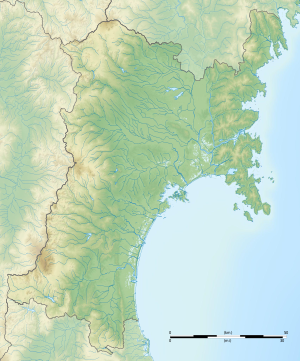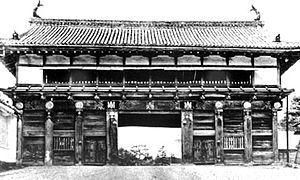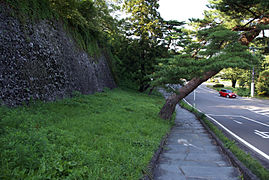Sendai Castle
| Sendai Castle | ||
|---|---|---|
|
Sendai Castle, watchtower on Ōte-mon |
||
| Creation time : | 1601-1610 | |
| Castle type : | Hirayamajiro (hill castle) | |
| Conservation status: | Partly reconstructed | |
| Place: | Sendai | |
| Geographical location | 38 ° 15 '8.9 " N , 140 ° 51' 22.2" E | |
|
|
||
The castle Sendai ( Japanese 仙台城 , Sendai-jō ), and Castle Aoba ( 青葉城 , Aoba-jō ), located in the city of Sendai , Miyagi Prefecture . In the Edo period , the Date resided there , who with an income of 580,000 Koku belonged to the great Tozama daimyo .
history
In 1600, just after the Battle of Sekigahara , received Date Masamune of Tokugawa Ieyasu permission to build a castle Sendai. Construction on the ridge of the Aobayama ( 青葉 山 ) began the following year and was largely completed in 1602, so that Masamune could move in. The expansion continued in the following years, so that in 1610 the enlargement of the inner area, the Hommaru, could be completed.
However, it was inconvenient to reach the central part on the hill. Therefore, Masamune's son Tadamune ( 忠 宗 ) decided to build a second castle area below the mountain, the Ni-no-maru, and to use it as a residence after completion in 1639.
The attachment
The castle hill is surrounded by the Hirose-gawa ( 広 瀬 川 ) in the north and east, and a steep slope protects it in the south. The Hommaru ( 本 丸 ) is about 115 m above sea level, north of it the Ni-no-maru ( 二 の 丸 ; 2) and San-no-maru ( 三 の 丸 ; 3), in front of it the area of the higher samurai (S) to the east. A bridge leads over the river, from which it goes up to the main gate in the north, the Ōte-mon (大 手 門, H). The castle area Higashi-no-maru (東 の Burg) was located above this entrance area. - The castle only had the base for a castle tower ( 天 守 閣 , Tenshukaku; red), but the Hommaru was protected by four three-story watchtowers ( 三重 櫓 , Sanjū-yagura). There was a residence in both the Hommaru and the Ni-no-maru. The residence in Hommaru was splendidly built in the style of the Momoyama period and is said to have been comparable to the Tokyotomi Hideyoshi's Jurakudai Palace in Kyoto.
As early as 1648 an earthquake destroyed parts of the castle, not all watchtowers were rebuilt. The castle then existed in this form as the seat of Date until it was abandoned as a result of the Meiji Restoration in 1868. After 1868 hardly any buildings remained, the rest was lost in a fire in 1882. In an air raid in 1945, the last original structure fell, the mighty main gate was lost. The watchtower to the side of it was restored in 1967.
photos
Remarks
- ↑ Doi Bansui composed the verses "Castle ruins in the moonlight" ( Kōjō no Tsuki ), which refer to the castle. The poem was set to music by Taki Rentarō .
literature
- Mizoguchi, Masafumi: Sendai-jo. In: Masayuki Miura (ed.): Shiro to jinya. Saikoku-hen. Gakken, 2006, ISBN 4-05-604379-5 .








